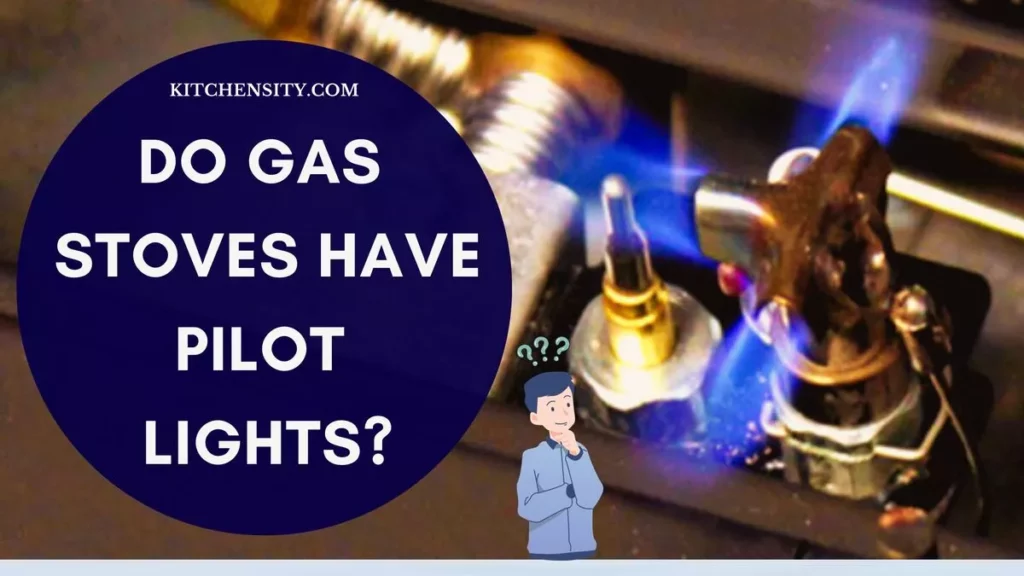In the modern kitchen’s hustle and bustle, gas stoves are reliable companions for passionate cooks and food enthusiasts. But as technology advances, so do the features of our everyday appliances.
One common question that arises among homeowners is: Do gas stoves have pilot lights anymore?
This article will delve into the heart of gas stoves, exploring their evolution and shedding light on this culinary mystery.

Table of Contents
- 1 Do Gas Stoves Have Pilot Lights?
- 2 How Do I Know If My Gas Stove Has A Pilot Light?
- 3 How To Light The Pilot On A Gas Stove Oven?
- 4 When Did Gas Stoves Stop Using Pilot Lights?
- 5 The Evolution Of Gas Stoves
- 6 Can You Light A Gas Stove Without A Pilot Light?
- 7 Final Thoughts: Do Gas Stoves Have Pilot Lights?
- 8 Frequently Asked Questions (FAQs)
- 8.1 Do New Gas Stoves Have Pilot Lights?
- 8.2 Are Pilot Lights Completely Obsolete In Gas Stoves?
- 8.3 Can Electronic Ignition Systems Be Repaired Easily?
- 8.4 Do Electronic Ignition Systems Consume A Lot Of Electricity?
- 8.5 Are There Any Safety Concerns With Electronic Ignition Systems?
- 8.6 Can I Upgrade My Old Gas Stove To Have An Electronic Ignition System?
Do Gas Stoves Have Pilot Lights?
No, not all gas stoves have pilot lights. Pilot lights are mostly found in older or specialty models, while standard stoves now rely on advanced technology for ignition. Modern gas stoves generally do not have pilot lights. Instead, they use electronic ignition systems to ignite the burners, which are more energy-efficient and safer.
Also Read – How To Fix A Pilot Light On A Gas Stove?
How Do I Know If My Gas Stove Has A Pilot Light?
If you’ve recently moved into a new home or upgraded your kitchen appliances, you might be wondering whether your gas stove features a pilot light. Unlike older models, many modern gas stoves no longer incorporate this continuous flame technology.
To help you identify whether your gas stove has a pilot light, follow these simple steps:
- Check The Stove’s Age: First, consider the age of your gas stove. If your stove is relatively old, it is more likely to have a pilot light. Stoves manufactured before the widespread adoption of electronic ignition systems, typically in the mid to late 20th century, often rely on pilot lights for ignition.
- Inspect The Stove Burners: Examine the burners on your stove carefully. If you see small, constantly burning flames near the burners, those are the pilot lights. Pilot lights are usually located near the base of the burners and are visible even when the stove is turned off.
- Look For Ignition Switches Or Buttons: Modern gas stoves equipped with electronic ignition systems don’t have pilot lights. Instead, they use electric ignition switches or buttons. These switches are typically located on the stove’s control panel. If your stove has buttons or switches that you need to press or turn to ignite the burners, it does not have a pilot light.
- Consult The User Manual: If you’re unsure about your gas stove’s features, refer to the user manual. The manual provides detailed information about the stove’s specifications and functionalities. It will clearly state whether your stove is equipped with a pilot light or an electronic ignition system.
- Contact The Manufacturer Or A Technician: If you’re still uncertain, consider reaching out to the stove’s manufacturer or a qualified technician. They can provide specific information about your stove model and guide you on its features. Technicians can also inspect your stove in person, ensuring you have accurate information about its ignition system.
Also Read – What Is An Infrared Gas Stove?
Where Is The Pilot Light On A Gas Stove?
If you have an older gas stove, it likely features a pilot light, which is a small, continuous flame used to ignite the burners. Here’s how you can locate the pilot light on your gas stove:
- Remove The Burner Grates: Start by removing the burner grates from the stove. These grates cover the burners and need to be lifted off carefully. Usually, they are not attached and can be removed easily by lifting them straight up.
- Inspect The Burner Assembly: Once the grates are removed, look closely at the area where the burners are placed. Near each burner, you should see a small metal tube with tiny holes. This tube is the pilot assembly. The pilot light is a small flame located at the end of this tube.
- Identify The Pilot Light: The pilot light is a very small, continuously burning flame. It might be blue or yellow, depending on the type of gas your stove uses. It’s often located at the base of the burner assembly and can be seen through the holes in the metal tube.
- Use A Lighter Or Matchstick To Relight: If your pilot light has gone out and needs relighting, use a long lighter or a long matchstick. Hold the flame close to the end of the pilot tube while turning the gas knob to the pilot position. Once the pilot light catches the flame, continue to hold the knob in for a minute or two to ensure the pilot light stays lit.
- Replace The Burner Grates: After ensuring the pilot light is lit and stable, carefully place the burner grates back on the stove. Make sure they are positioned correctly and sit securely on the burners.
- Double-Check For Safety: Always double-check to ensure there are no gas leaks. If you smell gas or suspect a leak, turn off the gas supply immediately and contact a professional technician for assistance.
Also Read – How To Clean An Infrared Gas Stove?
What Color Is The Pilot Light On A Gas Stove?
The pilot light on a gas stove is typically blue in color. When natural gas burns efficiently, it produces a blue flame. This blue flame indicates that the gas is burning cleanly and efficiently. A blue pilot light is a sign that the stove is operating properly and safely.
However, if the pilot light appears yellow or orange, it could indicate a problem. A yellow or orange flame suggests incomplete combustion, which can be caused by a variety of issues such as a dirty burner, a misaligned pilot, or a lack of oxygen. In such cases, it’s important to have the stove inspected and serviced by a professional technician to ensure safe operation and efficient combustion.
Also Read – My Gas Stove Making Noise When Off
How To Light The Pilot On A Gas Stove Oven?
If you have an older gas stove oven with a pilot light that has gone out, you can relight it by following these steps. Always prioritize safety and be cautious while dealing with gas appliances:
- Ensure Proper Ventilation: Before attempting to light the pilot light, ensure the kitchen area is well-ventilated. Open windows and doors to allow fresh air in and ventilate any accumulated gas fumes.
- Locate The Oven’s Access Panel: The pilot light is usually located at the back of the oven compartment. Remove the bottom drawer or, in some models, lift the oven floor to access the area where the pilot light is situated.
- Find The Pilot Light Assembly: Once you have access, locate the pilot light assembly. It typically consists of a small metal tube attached to the oven’s gas line. The pilot light itself is a small flame at the end of this tube.
- Turn The Oven Knob To ‘Pilot’: Turn the oven temperature control knob to the ‘Pilot’ position. This step allows gas to flow to the pilot light assembly.
- Use A Long Lighter Or Matchstick: Using a long lighter or a long-reach matchstick, ignite the flame at the end of the pilot light assembly. Hold the flame steady at the pilot light while continuing to press the oven control knob.
- Hold The Knob And Wait: Continue holding the oven control knob in the ‘Pilot’ position for about a minute after the pilot light ignites. This ensures the thermocouple (a safety device) heats up and allows the gas to keep flowing to the pilot light.
- Release The Knob: After a minute, release the oven control knob. The pilot light should stay lit. If it doesn’t, repeat the process, ensuring you hold the knob in the ‘Pilot’ position long enough for the thermocouple to heat up properly.
- Close Access Panel And Oven: Once the pilot light is lit and stable, close the oven’s access panel securely. If you had to lift the oven floor, place it back in its original position. Close the drawer, if applicable.
- Monitor The Flame: Keep an eye on the pilot light for a few minutes to ensure it remains lit and stable. If it goes out, do not attempt to relight it again immediately. Ventilate the area thoroughly and wait for a few minutes before trying again.
- Seek Professional Help If Necessary: If you encounter difficulties lighting the pilot or if it keeps going out, it’s best to contact a professional technician to inspect and repair your gas stove oven. Do not attempt to fix complex issues on your own.
Always prioritize safety when dealing with gas appliances. If you smell gas or suspect a leak, turn off the gas supply immediately, evacuate the area and contact emergency services and a qualified technician for assistance.
Also Read – How To Fix The Gas Stove Igniter Not Sparking After Cleaning?
When Did Gas Stoves Stop Using Pilot Lights?
Gas stoves largely stopped using pilot lights as a standard feature in the late 20th century, specifically during the 1980s and 1990s. During this time, manufacturers began transitioning from traditional pilot light systems to more advanced electronic ignition systems.
Electronic ignition systems, which use electricity to create sparks for igniting the gas, offer significant advantages over pilot lights. They were more energy-efficient and safer, as they eliminated the constant flow of gas associated with pilot lights. This change aligns with a broader trend in the industry toward more energy-efficient and environmentally friendly appliances.
As a result, by the early 2000s, the vast majority of newly manufactured gas stoves no longer featured pilot lights. Instead, they incorporated electronic ignition systems, becoming the standard in the industry. However, it’s essential to note that while pilot lights are no longer standard, some specialty or older models might still use them. Always refer to the specific product manual or consult the manufacturer if you’re uncertain about the features of a particular gas stove.
Also Read – Why Is My Gas Stove Not Clicking?
The Evolution Of Gas Stoves
In the early 19th century, as gas lighting gained popularity, inventors started experimenting with using gas for cooking. The first gas stoves were basic and consisted of a burner, fueled by natural gas or coal gas, controlled by a simple valve. These stoves were a significant departure from traditional wood or coal-burning stoves, offering a cleaner and more controllable source of heat.
The Introduction Of Pilot Lights
As gas stoves became more common in households, the introduction of pilot lights in the early 20th century revolutionized cooking. Pilot lights were small, continuously burning flames that kept the main burners readily ignited. This innovation made it convenient for users to light the stove without the need for matches or lighters, significantly improving the user experience.
Advancements In Burner Design
Throughout the mid-20th century, there were significant advancements in burner design. Burners became more efficient, distributing heat evenly and allowing for precise temperature control. This improvement was crucial for cooking delicate dishes that required specific heat levels, enhancing the versatility of gas stoves.
Also Read – Why Gas Stove Won’t Light But Smells Gas?
The Emergence Of Electronic Ignition Systems
In the latter half of the 20th century, electronic ignition systems made their debut in gas stoves. This marked a pivotal moment in the evolution of gas stoves, as electronic ignition systems eliminated the need for continuous pilot lights. Instead, a spark generator was used to ignite the gas when the user turned the stove knob. This not only saved energy but also enhanced safety by preventing gas leaks in case the flame went out accidentally.
Integration Of Smart Technology
In recent years, gas stoves have embraced smart technology, connecting to smartphones and other devices. Smart gas stoves offer features like remote control, temperature monitoring, and recipe integration. Users can now control their stoves with a simple app, making cooking more convenient and tailored to individual preferences.
Also Read – How To Fix A Yellow Flame On A Gas Stove?
Focus On Energy Efficiency And Sustainability
Modern gas stoves are designed with a strong focus on energy efficiency and sustainability. Advanced burner designs and precise temperature controls reduce energy wastage, making them environmentally friendly. Additionally, there is a growing emphasis on using cleaner fuels and eco-friendly materials in the manufacturing process, aligning gas stoves with the global push for sustainable living.
Can You Light A Gas Stove Without A Pilot Light?
Yes, you can light a gas stove without a pilot light. If you have an older gas stove without an electronic ignition system or a pilot light, you can still light the stove manually. Here’s how you can do it:
- Check The Burner: Make sure the burner is clean and free from debris. Any blockage can hinder the flow of gas.
- Locate The Gas Supply Valve: Find the gas supply valve usually located behind the stove. Ensure it is turned on. If your stove has a separate gas valve for each burner, check the specific valve corresponding to the burner you want to light.
- Use A Long-Handled Lighter Or Matchstick: Light a long-handled lighter or a long matchstick. Hold the flame near the burner you want to light.
- Turn The Burner Knob To Ignite: Turn the burner knob of the desired burner to the “Light” or “Ignite” position. While holding the flame near the burner, listen for the hissing sound of the gas. The gas should catch fire and create a flame when it comes into contact with the lit matchstick or lighter.
- Adjust The Flame: Once the burner is lit, you can adjust the flame size using the burner knob. Turn the knob towards the “Low” position for a lower flame and the “High” position for a higher flame.
- Ensure Stability: Make sure the flame is stable and not flickering excessively. A stable flame indicates proper combustion.
- Turn Off The Burner: When you’re done cooking, turn the burner knob to the “Off” position to extinguish the flame. Also, ensure the gas supply valve behind the stove is turned off.
Always exercise caution when working with open flames and gas appliances. If the burner does not light after a few attempts, turn off the gas supply and ventilate the area before investigating the issue. If you encounter difficulties, it’s best to seek assistance from a professional technician to avoid any safety hazards.
Also Read – Orange Flame On The Gas Stove: Causes And Fixes
Final Thoughts: Do Gas Stoves Have Pilot Lights?
In conclusion, gas stoves have come a long way from the days of pilot lights. Modern stoves mostly use electronic ignition, making them safer and more energy-efficient. Although some older models and specialty stoves might still have pilot lights, the standard has shifted towards advanced technology.
Regardless of the type of stove you have, it’s important to handle gas appliances with care and follow safety guidelines. Whether you’re cooking on a classic stove with a pilot light or a modern one with electronic ignition, the joy of preparing delicious meals in your kitchen remains timeless.
Stay Safe, And Happy Cooking!
Also Read – Why Electric Stoves Take Forever To Boil Water?
Frequently Asked Questions (FAQs)
-
Do New Gas Stoves Have Pilot Lights?
No, most new gas stoves do not have pilot lights. Pilot lights are not a standard feature in all gas stoves, with many modern models using electronic ignition systems for safer and more energy-efficient operation.
-
Are Pilot Lights Completely Obsolete In Gas Stoves?
Yes, most modern gas stoves no longer have pilot lights. They have been replaced by more energy-efficient and safer electronic ignition systems.
-
Can Electronic Ignition Systems Be Repaired Easily?
Yes, electronic ignition systems are relatively easy to repair and maintain. However, it’s advisable to consult a professional technician for any repairs to ensure safety.
-
Do Electronic Ignition Systems Consume A Lot Of Electricity?
No, electronic ignition systems consume minimal electricity. They only use power when you’re turning on the stove, making them energy-efficient.
-
Are There Any Safety Concerns With Electronic Ignition Systems?
Electronic ignition systems come with safety features. They automatically shut off the gas supply if the flame goes out, preventing potential gas leaks and hazards.
-
Can I Upgrade My Old Gas Stove To Have An Electronic Ignition System?
In most cases, it’s possible to upgrade older gas stoves to include electronic ignition systems. However, it’s recommended to consult a professional technician to assess the feasibility and safety of the upgrade.
🔧 Stove Expert | 🔥 Gas Guru | 🏠 DIY Enthusiast | 🎨 Painter Extraordinaire
John Davis is your go-to source for all things stoves, from expert repairs to maintenance tips. With a deep understanding of gas systems, including natural and propane, John ensures your kitchen stays cooking safely. His passion for DIY home and kitchen projects shines through his stunning paint transformations. Trust John to bring warmth and functionality to your home, one stove at a time.






